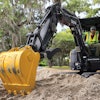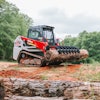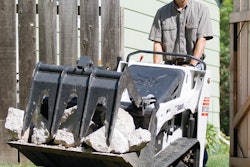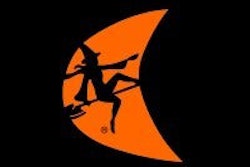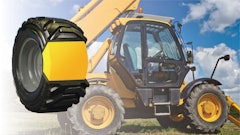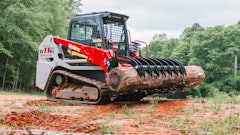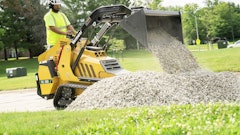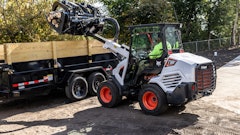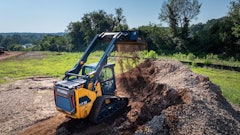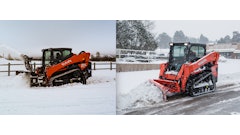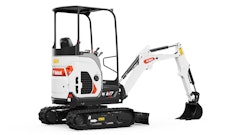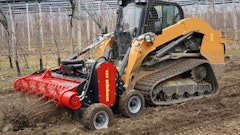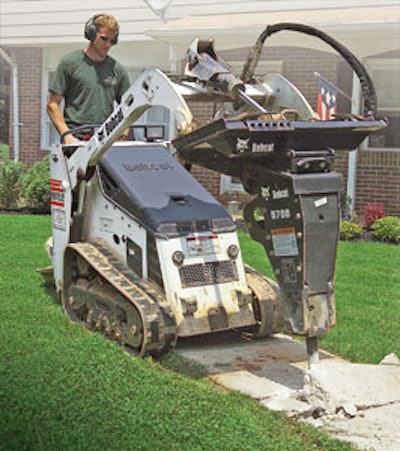
Work smarter, not harder - that's the motto by which Benjy Gold runs his contracting business. To this end, he states, "Let the 'dirt dogs' do it."
The "dogs" he's referring to are his Compact Power Boxer and Toro Dingo compact utility loaders. These small, power-packed machines are the backbone of his Tega Cay, SC, company, which caters to the needs of swimming pool companies.
"In order to work smarter, you need to learn what each piece of equipment can do," Gold indicates.
With that in mind, Gold relies on his rubber-tracked TD-327 Boxer for heavy lifting and digging. The unit's 26-hp diesel engine enables it to trench and auger faster. And its retractable track system can be converted to just 34.5 in. wide, narrow enough to easily fit through standard garden gate openings. Once through the gate, the tracks can be expanded to 43.5 in. for stability.
Gold's 22-hp gas-powered wheeled Dingo is used for grooming and finish work, as well as trenching for silt fences. And until a few weeks ago, when he added a compact excavator to his fleet, Gold also used the Dingo with a backhoe attachment for plumbing pools.
Wheels or tracks?
Though Gold has both wheeled and tracked machines, many contractors have one or the other. And while application and working conditions are a major factor, choosing between wheels or tracks often comes down to user preference.
Toro offers both options on its Dingo units. As Greg Lawrence, Dingo product manager, explains, each has its distinct advantages. Wheeled units tend to be a bit more compact as far as geometry, and they have more traditional skid-steer-style turning. "With this zero-turn capability, you can maneuver in and out of tight spaces easier with wheels than you can with tracks," he indicates. "Some contractors simply prefer a mini loader with wheels because they are more familiar with the turning style and maneuverability."
Wheeled units will also wear a little better on hard surfaces such as concrete, he continues. And their tires can be swapped out to address specific surface conditions, such as switching between turf tires, with a smoother tread that's more gentle on lawns, and agricultural tires that promote more aggressive traction in muddy conditions.
In addition, wheeled units can be safer to operate when working over large mounds or curbs because the break between the front and rear tires keeps the tires in contact with the ground at all times.
They also tend to be a bit faster in actual ground speeds, says Andy Lewis, marketing manager for Compact Power Inc., which offers wheeled and tracked versions. "A contractor working in hard ground may be better off with a wheeled unit where he can auger as many holes as possible," he says.
Tracked units have the upper hand when working with certain attachments, such as a trencher or vibratory plow, since they have more rubber on the ground for added tractive power with less slippage.
Manufacturers are also configuring tracked models with easy-to-operate controls for direction, speed and attachment functions. For example, on Bobcat track compact utility loaders, operators can set the reverse travel speed with a reverse speed limiter knob on the control panel. This is particularly useful when a constant speed is desired, such as when using a trencher attachment.
Easy to use controls enable even inexperienced operators to become proficient quickly, says Toro's Lawrence. "With the user-friendly controls in our traction (track) units, someone who has never run the machine can be up and running in a matter of minutes," he states.
But the real benefit of a tracked unit is the ability to work in sandy or muddy conditions where wheeled models can be rendered useless.
"They can get across a surface much easier without getting stuck," says Mike Lumbers, product manager for the Ditch Witch organization. "Tracks are becoming more popular in applications where flotation is important. They can disperse the load over a larger area so they do less damage to surfaces such as grass or turf."
"Bobcat models have a rubber track undercarriage that distributes the machine's weight," adds Gerald Zastrow, Bobcat loader product representative. "This feature provides excellent flotation over existing surfaces such as a customer's lawn or concrete patio."
Zastrow notes that the Bobcat MT52 produces 5.2 psi of ground pressure, while the MT55 has just 4.1 psi due to its wider tracks. "This is particularly useful for remodeling projects or additions," he says. "It saves the contractor time and money with fewer repairs to the turf when the project is complete. This can translate into higher profits. It's a win-win situation. Plus, tracks never go flat, and they keep the machine moving in soft, wet or muddy ground conditions."
This go-anywhere feature is what attracted Ed Reid, owner of Reid Construction, Manchester, MD, to purchase a Bobcat MT52 in April 2004. Reid focuses on various types of residential concrete work, such as footings, small retaining walls, dry cement walls, stamped concrete, walkways and patios.
Reid considered a wheeled unit, but opted for one with tracks to get through tough ground conditions when excavating. "It was a little more pricey," he admits, "but I can get anywhere and I don't have to worry about flats.
"This loader is no slouch when it comes to performing tasks," he adds, noting that his arsenal of attachments includes a 3-ft. auger, a hammer, a sweeper, forks, buckets and a snow blower. "With the auger attachment, it digs every bit of a 6-ft. hole. It has been limitless. I have yet to find anything that it can't do. You couldn't take this machine away from me."
Reid purchased the machine as a replacement for a traditional skid-steer loader. With its lower hydraulic flow rate, the compact utility loader runs a bit slower, but he feels the small sacrifice is not enough to worry about. "The advantages of less ground disturbance and lower fuel consumption outweigh the little bit longer time it might take to finish a task," he says. "With this machine, I can do more intricate work, and it's small enough that I can see the work that I'm doing. My other machine was just a little too big."
To help contractors reap the benefits of both types of loaders, some manufacturers offer over-the-tire tracks for wheeled units. For example, Toro offers both steel and rubber tracks to give wheeled models the same versatility of tracked machines when operating on tough ground conditions.
Packed with hydraulic power
The compact utility loader's smaller size is typically what attracts many contractors. But don't be fooled by its small footprint.
"A smaller machine doesn't necessarily do a smaller job," says Mike Beaufait, Compact Power, Inc. "One reason this equipment is so popular with contractors is that it has the same power as their bigger equipment in terms of hydraulic power, but it's in a smaller format."
As a case in point, he notes, "With many traditional-size skid steers a portion of the hydraulic output is always allocated to the drive system. So even a skid steer with a higher hydraulic flow rate of 15 gpm can only utilize 10 to 12 gal. of hydraulic flow at the attachment end."
With a Compact Power loader, you have the ability to manipulate hydraulic flow rate to optimize flow to an attachment, says Beaufait. For example, a contractor using a compact utility loader with a 12-gpm flow rate can eliminate the drive function and put all 12 gal. towards an attachment, such as an auger.
"He doesn't need to drive around to do that task, so he can utilize that extra hydraulic flow at the attachment," he says. Or he can allocate a portion of the flow towards the drive system and the rest towards the attachment. Collateral damage to existing turf is minimized because part of the flow is diverted away from the drive system, reducing tire spin, especially while trenching or pulling pipe on wet surfaces.
Trailer packages
Like its big brother, a compact utility loader is able to power a large variety of attachments. However, because they have a lower up-front cost compared to traditional-sized skid steers, some contractors prefer to purchase several attachments as a package with the machine. This is typically less expensive than buying attachments individually due to the supplier's ability to provide discounts on volume sales, Lumbers points out.
In many cases, the package will include a trailer, which simplifies storage and transportation. Trailers can often be customized according to the attachments purchased.
"Trailer packages have an advantage because everything is stored and transported together," says Lawrence. "Having a dedicated place for each piece of equipment gives you an organized system where access to attachments is simpler and faster, and everything is easier to transport. Because each attachment is compartmentalized, you don't have to worry about leaving anything behind."
"It's sort of a toolbox mentality," adds Beaufait. "You can transport a multitude of job functions in one trip, as opposed to having to use multiple trailers full of attachments to do the same number of functions."
